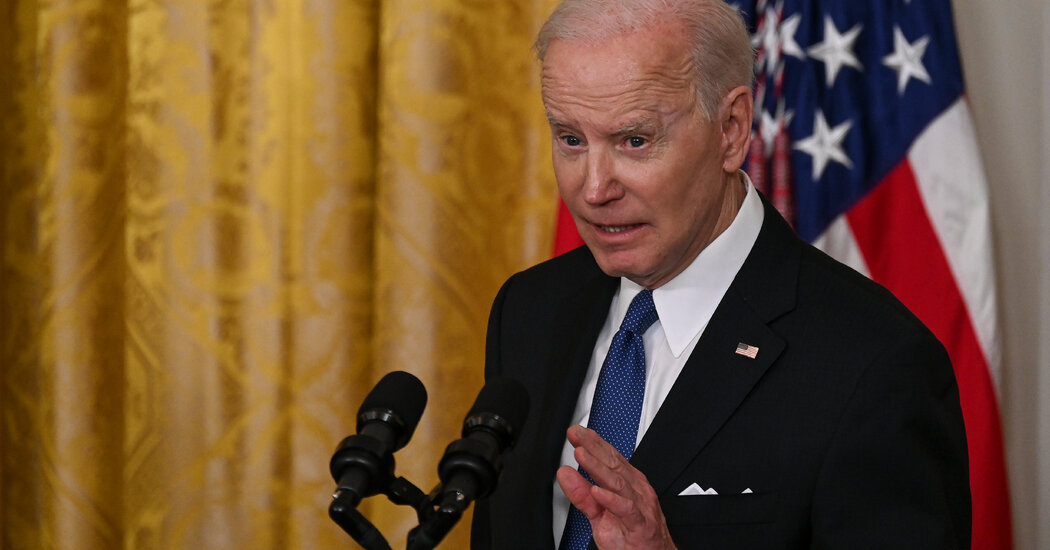
President Biden, under fire for rapid inflation and looking for ways to help cushion rising costs for households, extended a moratorium on student debt payments through August. While politically popular with Mr. Biden’s party, the move drew criticism for adding a small measure of oomph to the very inflation the government is trying to tame.
America’s robust economic recovery from the deepest pandemic-era lockdowns has left consumers with the power to spend and has fueled fast price increases. Those rising costs are making voters unhappy, jeopardizing Democrats’ chances of retaining control of Congress come November.
The moratorium extension stood out as an example of a more general problem confronting the administration: Policies that help households stretch their budgets could soothe voters, but they could also add a little bit of fuel to the inflationary fire at an inopportune moment. And perhaps more critically, analysts said, they risk sending a signal that the administration is not focused on tackling price increases despite the president’s pledge to help bring costs down.
Inflation is running at the fastest pace in 40 years and at more than three times the Federal Reserve’s 2 percent goal, as rapid buying collides with constrained supply chains, labor shortages and a limited supply of housing to push prices higher.
The administration’s decision to extend the student loan moratorium through Aug. 31 will keep money in the hands of millions of consumers who can spend it, helping to sustain demand. While the effect on growth and inflation will most likely be very small — Goldman Sachs estimates that it probably adds about $5 billion per month to the economy — some researchers say it sends the wrong message and comes at a bad time. The economy is booming, jobs are plentiful and conditions seem ideal for transitioning borrowers back into repayment.
“Four months by itself is not going to get you dramatic inflation,” Marc Goldwein of the Committee for a Responsible Federal Budget said, noting that a full-year moratorium would add only about 0.2 percentage points to inflation, by his estimate. “But it’s four months, on top of four months before that.”
Extra help for student loan borrowers could, at the margin, work at cross-purposes with the Fed’s recent policy changes, which are meant to take away household spending power and cool down demand.
The Fed in March lifted interest rates for the first time since 2018, and it is expected to make an even larger increase in May as it tries to slow spending and give supply chains some breathing room. It is trying to weaken the economy just enough to put inflation and the economy on a sustainable path, without plunging it into a recession. If history is any guide, pulling that off will be a challenge.
A chorus of economists took to Twitter to express frustration at the decision on Tuesday, when news of the administration’s plans broke.
“Wherever one stands on student debt relief this approach is regressive, uncertainty creating, untargeted and inappropriate at a time when the economy is overheated,” wrote Lawrence H. Summers, a former Democratic Treasury secretary and economist at Harvard who has been warning about inflation risks for months. Douglas Holtz-Eakin, a former Congressional Budget Office director who now runs the American Action Forum, which describes itself as a center-right policy institute, summed it up thusly: “aaaaaaarrrrrrRRRRGGGGGGGGHHHHHHHH!!!!!!!!!!”
Yet proponents of even stronger action argued that the moratorium was not enough — and that the affected student loans should be canceled altogether. Senators Chuck Schumer of New York, the Democratic leader, and Elizabeth Warren of Massachusetts are among the lawmakers who have repeatedly pressed Mr. Biden to wipe out up to $50,000 per borrower through an executive action.
That stark divide underlines the tightrope the administration is walking as the Nov. 8 elections approach, with Democratic control of the House and the Senate hanging in balance.
“They’re buying political time,” Sarah A. Binder, a political scientist at George Washington University, said in an email. “Kicking the can down the road — with another extension, surely, before the elections this fall — seems to be the politically optimal move.”
The administration is taking a calculated risk when it comes to inflation: Student loan deferrals are unlikely to be a major factor that drives inflation higher this year, even if they do add a little extra juice to demand. At the same time, continuing the policy avoids a political brawl that could tarnish the administration and the Democratic Party’s reputation ahead of the November vote.
White House officials emphasized on Wednesday that the small amount of money the deferrals were adding to the economy each month would have only a marginal impact on inflation. But they could help vulnerable households — including those that did not finish their degrees and that have worse job prospects.
The Federal Reserve Bank of New York suggested in recent research that some borrowers might struggle under the weight of payments and post a “meaningful rise” in delinquencies once payments start again. Mr. Biden referred to that Fed data during his announcement. The Education Department suggested that borrowers would be given a “fresh start” that will automatically eliminate delinquency and defaults and allow them to begin repayment, once it resumes, in good standing.
“We are still recovering from the pandemic and the unprecedented economic disruption it caused,” Mr. Biden said.
Student Loans: Key Things to Known
The move could also blunt the pain of an inflationary moment for some households. Voters are deeply unhappy as inflation eats away at paychecks and cancels out pay gains for many workers. A recent Gallup poll showed that concerns about inflation have surged to their highest level since the 1980s, and though they are lower among Democrats than among Republicans, they are rising across partisan lines.
Some proponents of extending the moratorium cited inflation as part of their reasoning.
“This is an important step to ensure that working families’ expenses aren’t going up as we work to fight inflation and corporate greed,” Representative Pramila Jayapal, Democrat of Washington, wrote on Twitter.
But the reality that the move could add to inflation at the margin, and that it comes at a time when the economy is chugging along solidly, prompted critics to argue that it is difficult to make an economic case for the extension.
“From an economic perspective, it’s a very bad decision,” said Ben Ritz, the director of the Progressive Policy Institute’s Center for Funding America’s Future. “It’s very expensive, it’s inflationary, it’s regressive. They’re doing it a couple of months at a time, so it’s creating uncertainty for borrowers.”
Unemployment among college graduates, the biggest beneficiaries of student loan payment deferrals, is currently at just 2 percent. For those who have no degree — people who have graduated only from high school — unemployment is at 5.2 percent, roughly matching its prepandemic level.
By “regressive,” Mr. Ritz means that student loan deferrals tend to help relatively high-income families. Accounting for the value of an education and adjusting for existing student relief programs, one Brookings Institution analysis found that almost a third of all student debt is owed by the wealthiest 20 percent of households and only 8 percent by the bottom 20 percent.
The program was meant to provide relief during the depths of the pandemic, but it has now been extended seven times. Now it will put borrowers in a better financial position to afford houses, ballet lessons and new couches — whatever they want to spend their money on instead of payments — just as the central bank’s interest rate increases try to take spending power out of the economy.
“It absolutely makes the Fed’s job harder,” Mr. Ritz said.
Stacy Cowley contributed reporting.




